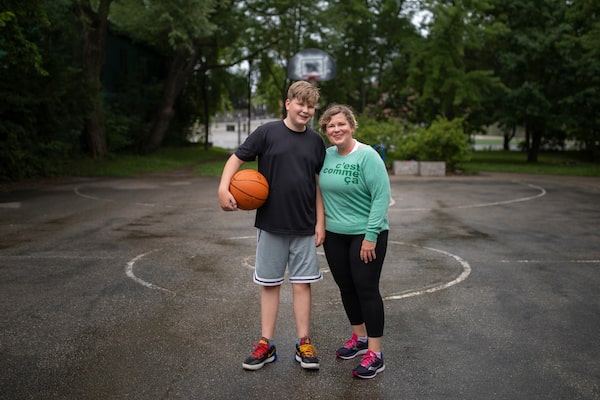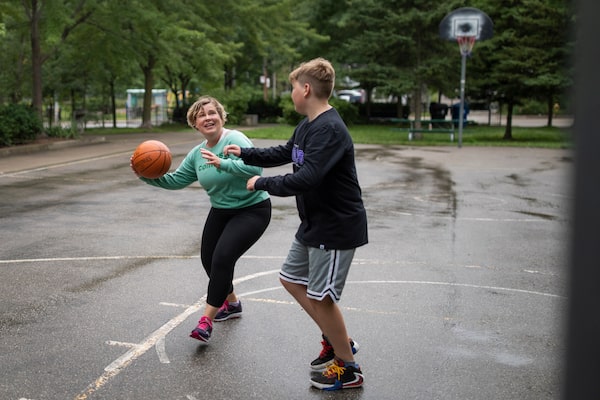
Anne Shone and her son Daniel play basketball at the Coxwell Avenue Parkette, not far from their home in the east end of Toronto.NICK IWANYSHYN/THE GLOBE AND MAIL
Back in early July, Anne Shone, Toronto mom and children’s book editor, found herself with a full day of errands. There was an orthodontist appointment for her 12-year-old son Daniel, plus a 90-minute basketball practice with his club, the Toronto Lords.
Two entries on the family calendar? It felt like a blast from the pre-pandemic past.
“It was the busiest day,” she says now, laughing. “I didn’t know what to do!”
That busy day was a long time coming. Like nearly every other kid’s recreational and competitive sport in Canada, Daniel’s basketball practices and games were cancelled or curtailed during the COVID-19 pandemic. That collective pause has had serious consequences for children and the sports clubs, teams and organizations that keep them active.
According to one Canadian study, only 4.8 per cent of children (ages 5-11) and 0.6 per cent of youth (ages 12-17) were meeting movement and activity guidelines earlier in the pandemic. Forget adequate physical activity and sleep: Kids were trading that in for increased screen time while cooped up indoors.
“It’s not good,” says Richard Way, CEO of Sport For Life in Victoria, B.C., whose own non-profit organization’s survey revealed that 71 per cent of local sports organizations across Canada expected long-term hardship; 66 per cent either laid off staff or planned to; and 21 per cent didn’t expect to survive without financial support.
“We’re worried there won’t be the same rich selection of viable sport organizations available to Canadians coming out of COVID.”
Part of the worry, he explains, is that people are creatures of habit, and now that children have been off the field, rink or court, local clubs will have a more difficult time luring them back.
“All of this is compounded in lower income communities,” he explains. “That’s a real concern.”
Dave Sandford, CEO of Gymnastics Ontario and a former high-performance tumbling coach, says he’s already seen clubs close for good due to the pandemic. Ontario has been one of the country’s hardest hit provinces and the majority of local clubs have struggled.
True, many offered day camps this summer to stay afloat, but they’ve had to follow a laundry list of rules until the province opens fully: no indoor activities and no flight elements. In other words, front rolls, cartwheels and walkovers are okay. But no back tucks or handsprings, and forget anything requiring equipment beyond boxes and mats.
When clubs resume, expect fees to increase to make up for losses, but also to supplement smaller class sizes due to capacity restrictions.
If that weren’t bad enough, Mr. Sandford has only one word to describe competitive gymnastics in the province: “Devastated.”
With clubs completely closed for roughly eight months, the impact will be felt for years. Gymnastics is what is called an “early specialization sport,” meaning that gymnasts typically hit their peak as teens. It’s hard to make up for lost time when there isn’t much training time to begin with. He predicts a trickle-down effect for the 2024 and 2028 Olympics.
While some athletes have installed chin up bars at home and have tried to stay in shape, it likely won’t be enough as they can’t duplicate the swings and rotations on home equipment. And don’t forget the “rips” they’ll experience once back in the gym. With hard calluses on hands gone, getting back into training can be painful.
“Buy Band-Aid stock,” quips Mr. Sandford.
Heather McIntosh, a mother and physiotherapist in Guelph, Ont., says both her teen boys, Scott, 13 and Colin, 14, have missed playing hockey and baseball since the pandemic began. They were in the middle of Select baseball tryouts in March, 2020.
“We got a PS4 [Sony PlayStation video game] because they were lonely,” she says.
Scott also spent hours by himself shooting pucks at a net in the driveway, while Colin missed hanging out with his friends on his baseball team. Even the parents felt socially isolated when hockey opened briefly. Only one parent per family could watch rink-side, and those watching had to be physically distanced and sit apart.
Even now that baseball is slowly opening again (in a heartbreaking twist, Colin’s first game was rained out) things are still not the same. No high-fives, no pre-game cheers with hands covering hands in the middle of the circle, no handshakes and no hanging out in the dugout together.

Ms. Shone is happy that her son’s basketball coach plans to slowly ease the kids back.Nick Iwanyshyn/the globe and mail
So, what needs to be done to ensure children stay active and enjoy sport again? It takes a village, explains Sport for Life’s Mr. Way. He would like to see Canadian schools step up next year to offer more quality physical education to get kids back into the habit of moving. If recreation departments and sports clubs have to raise their rates, he suggests they offer scholarships or benefactor funds, so all kids get a chance to play.
Ms. Shone is happy that her son’s basketball coach plans to slowly ease the kids back. The goal is to instill the love of the game, rather than train extra hard to regain lost skills.
It’s an approach that just feels right as the country emerges from lockdowns. Ms. Shone recounts the story of a teammate’s father who felt tears welling up as he carpooled some of the kids recently. It had been so long since the dad had heard loud pre-teen chatter. Ms. Shone says she can’t wait for her turn behind the wheel and to feel some sense of normalcy too.
“I’ll never complain about any of those weekends driving and having boys in the back seat being completely goofy,” she says now. “I’ll never complain about that again.”